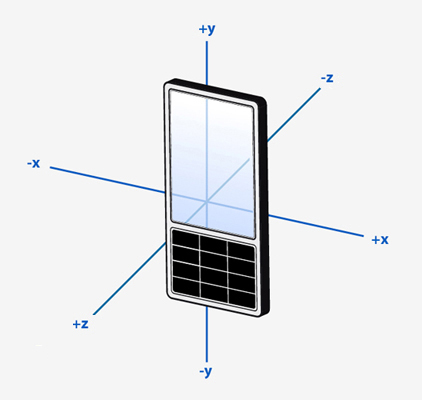- class QAccelerometerReading#
The
QAccelerometerReadingclass reports on linear acceleration along the X, Y and Z axes. More…Synopsis#
Properties#
Methods#
Note
This documentation may contain snippets that were automatically translated from C++ to Python. We always welcome contributions to the snippet translation. If you see an issue with the translation, you can also let us know by creating a ticket on https:/bugreports.qt.io/projects/PYSIDE
Detailed Description#
QAccelerometerReading Units#
The scale of the values is meters per second squared. The axes are arranged as follows.

A monoblock device sitting at rest, face up on a desk will experience a force of approximately 9.8 on the Z axis (ie. towards the roof). This is the proper acceleration the device experiences relative to freefall.
Note
Properties can be used directly when
from __feature__ import true_propertyis used or via accessor functions otherwise.- property xᅟ: float#
This property holds the acceleration on the X axis..
The scale of the values is meters per second squared.
See also
QAccelerometerReading Units- Access functions:
- property yᅟ: float#
This property holds the acceleration on the Y axis..
The scale of the values is meters per second squared.
See also
QAccelerometerReading Units- Access functions:
- property zᅟ: float#
This property holds the acceleration on the Z axis..
The scale of the values is meters per second squared.
See also
QAccelerometerReading Units- Access functions:
- setX(x)#
- Parameters:
x – float
Sets the acceleration on the X axis to
x.See also
- setY(y)#
- Parameters:
y – float
Sets the acceleration on the Y axis to
y.See also
- setZ(z)#
- Parameters:
z – float
Sets the acceleration on the Z axis to
z.See also
Getter of property
xᅟ.Getter of property
yᅟ.Getter of property
zᅟ.